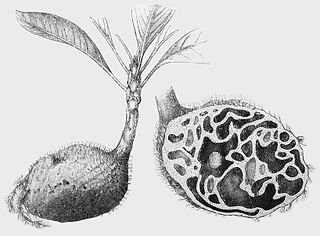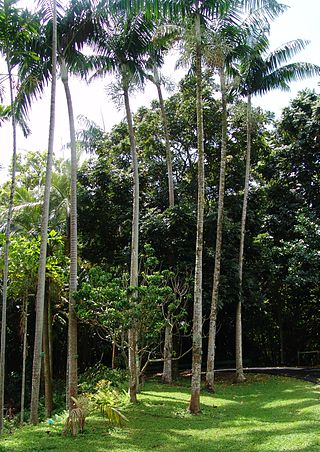
Trachycarpus fortunei, the Chinese windmill palm, windmill palm or Chusan palm, is a species of hardy evergreen palm tree in the family Arecaceae, native to parts of China, Japan, Myanmar and India.

Odoardo Beccari was an Italian botanist famous for his discoveries in Indonesia, New Guinea, and Australia. He has been called the greatest botanist to ever study Malesia. His author abbreviation is Becc. when citing a botanical name.

Acrocomia crispa, the Cuban belly palm or corojo, a palm species which is endemic to Cuba. Formerly placed in its own genus, Gastrococos, recent work found that that genus was nested within Acrocomia. It is a tall, spiny palm with a trunk that is slender at the base, but swollen in the middle, giving it the name "Cuban belly palm" in English.

Neoveitchia is a genus of palm trees.

Balaka is a genus of 11 known species in the palm family, Arecaceae or Palmae. Seven species are native to the islands of Fiji and four to Samoa. The genus was first proposed and published in Annales du Jardin Botanique de Buitenzorg 2: 91. 1885, from two species originally in the genus Ptychosperma.
Dryobalanops beccarii, or kapur merah, is a species of plant in the family Dipterocarpaceae. It is named after Odoardo Beccari (1843–1920), an Italian explorer and botanist. The species is found in Peninsular Malaysia and Borneo. It grows as a large emergent tree, up to 65 m (210 ft) tall, and is found in mixed dipterocarp forests on shallow leached soils over both sandstone and shale. Its heavy hardwood is sold under the trade names of kapur. Dryobalanops beccarii is recorded from a number of protected areas including Bako, Gunung Gading, Kubah and Santubong national parks.

Borassus heineanus is a species of a large solitary fan palm found only in northern New Guinea, in both Papua New Guinea and Indonesia, where it is threatened by habitat loss.

Vonitra is a valid genus of African palms, family Arecaceae, first described by Odoardo Beccari in 1878. Species occur in Madagascar and previously have been placed in the genus Dypsis; the type species is Vonitra fibrosa.
Dransfieldia is a monotypic genus of flowering plant in the palm family from western New Guinea where the lone species Dransfieldia micrantha grows in dense rain forest. Discovered in 1872, 134 years passed before DNA testing revealed its proper placement. With no close relatives, it is a delicate, pinnate-leaved palm named after John Dransfield, former palm expert at the Kew Royal Botanic Gardens.

Hydnophytum is a genus of epiphytic myrmecophytes native to Southeast Asia, the Pacific region and also extending into Queensland in northern Australia. The name is derived from the Ancient Greek hydnon "tuber", and phyton "plant", after their appearance with their swollen succulent stems. The species grow in tree branches and on trunks. Like the related genus Myrmecodia, they are known as antplants or ant-house plants. The type species is Hydnophytum formicarum from the Philippines. The genus contains 55 species, of which 44 are found in and around the island of New Guinea. Many are poorly known, with 11 known only from the holotype.

Cyrtostachys renda, also known by the common names red sealing wax palm and lipstick palm, is a palm that is native to Thailand, Malaysia, Sumatra and Borneo in Indonesia. It is the only species of the genus Cyrtostachys that can be found to the west of the Wallace Line, the faunal boundary separating the biogeographic realms of Asia and Wallacea. Cyrtostachys renda's name is derived from several words: the Greek prefix κυρτό- (cyrto-) meaning bent or curved, the Greek word σταχυς (stachys) meaning "an ear of grain", and "renda" a Malayan Aboriginal word for palm, which happens to be homonymous to the Portuguese word "renda," meaning income.

Dillenia alata, commonly known as red beech, golden guinea flower or golden guinea tree, is a tree in the Dilleniaceae family, found in tropical forests of the Moluccas, New Guinea, and northern Australia.

Livistona decora is a species of palm endemic to the sclerophyll woodlands, rainforests, and coastal strands of Queensland, Australia. It is known only from Magnetic Island near the City of Townsville, and south along the coast as far as Rainbow Beach. The species is now widely cultivated in arid regions worldwide as a decorative plant.

Veitchia arecina, commonly known as Montgomery palm, is a species of flowering plant in the family Arecaceae. It grows to between 25' and 35' and has white or yellow blooms.
Myrmephytum is a genus of myrmecophytic flowering plants in the family Rubiaceae. It is distributed from central Malesia to New Guinea.

Durio graveolens, sometimes called the red-fleshed durian, orange-fleshed durian, or yellow durian, is a species of tree in the family Malvaceae. It is one of six species of durian named by Italian naturalist Odoardo Beccari. The specific epithet graveolens is due to the odor. Although most species of Durio have a strong scent, the red-fleshed type of D. graveolens has a mild scent. It is native to Southeast Asia.

Corsia ornata is a species of flowering plant in the genus Corsia of the small family Corsiaceae, part of the monocot order Liliales. They are saprophytes (Myco-heterotrophs), lacking the ability to photosynthesise, being dependent on other organisms for their nutrition. The plant lives underground, sending up purplish stems above ground in order to flower. The leaves are reduced to scales. One of the six petal-like tepals named the labellum, is specialised, being enlarged and hanging protectively over the reproductive organs. It was discovered in New Guinea in 1875, but has since been sighted in Queensland, Australia.

Cosmophasis gemmans is a species of jumping spider in the family Salticidae. Only the male has been described. The type specimen is deposited at the Museo Civico di Storia Naturale di Genova. These spiders are typically found on the Indonesian island of Sumatra.

Hydnophytum moseleyanum, commonly known as smooth ant plant, is a plant in the coffee and gardenia family Rubiaceae native to the Philippines, New Guinea and Cape York Peninsula in Australia. It is an epiphyte that inhabits mangrove forest and rainforest, and it forms a symbiotic relationship with certain species of ants.
















